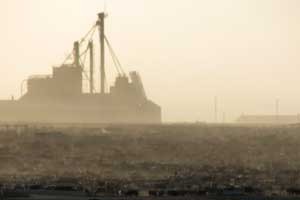Environmental Scientists Find Antibiotics, Bacteria, Resistance Genes in Dust from Feedlots

Brett Blackwell After testing dust in the air near cattle feedlots in the Southern High Plains, researchers at The Institute of Environmental and Human Health at Texas Tech University found evidence of antibiotics, feedlot-derived bacteria and DNA sequences that encode for antibiotic resistance.
The study was published online today in the National Institutes of Environmental Science’s peer-reviewed journal, Environmental Health Perspectives. The research was funded through a grant from Texas Tech’s College of Arts and Sciences. It is the first study documenting aerial transmission of antibiotic resistance from an open-air farm setting.
Phil Smith, an associate professor of terrestrial ecotoxicology at the institute, said that while scientists couldn’t assess if the amounts of these materials were dangerous to human health, it helped explain a previously uncharacterized pathway by which antibiotic-resistant bacteria could travel long distances into places inhabited by humans.
The findings come weeks after a report commissioned by British Prime Minister David Cameron concluded that failure to battle drug-resistant infections and their causes could result in 10 million extra deaths a year by 2050 at a cost of $100 trillion to the global economy.
“You can look in the news, and people are raising red flags about antibiotic resistance all the time,” Smith said. “Microbes are pretty promiscuous with their genetic information, and they share it across species fairly easily. We know it’s there. We know what causes it, but we don’t have a really good handle on how it’s transmitted and how it moves in the environment. This is an attempt to provide better clarity on that issue.
“Everyone is fairly certain antibiotic resistance comes from extensive use of antibiotics in animal-based agriculture. About 70 percent of all antibiotics used are for animal agricultural purposes. Overuse contributes to antibiotic resistance. But how does it happen? How does it get from where the drugs are used into the human environment and natural environment?”
Smith said scientists collected air samples upwind and downwind of each feedlot. After analysis, they found greater amounts of bacteria, antibiotics and DNA sequences responsible for antibiotic resistance downwind of the feedlots compared to upwind, which helped scientists determine the source of the materials they found.
Because the antibiotics are present on the particulate matter with bacteria, the selective pressure for bacteria to retain their resistance remains during their flight, said Greg Mayer, an associate professor of molecular toxicology at the institute.
With wind blowing regularly on the Southern High Plains, the antibiotics and bacteria can travel on the dust and particulate matter far from the original starting point at the feedlot. Add the infamous West Texas dust storms into the picture, and these materials have the potential to travel hundreds of miles into cities and towns and possibly around the globe.
“I think implications for the spread of some feedlot-derived, antibiotic-resistant bacteria into urban areas is paramount to the research,” Mayer said. “Now, we haven’t yet taken samples from an urban area to determine whether bacteria from that particulate matter originated from feedlots or whether it still has antibiotic resistant bacteria on it. However, this study is proof of the principle that antibiotic-resistant bacteria could plausibly travel through the air.
“Further studies are now needed to show where the particulate matter is traveling and what is happening to its passengers when it gets there.”
For a copy of the report, visit http://ehp.niehs.nih.gov/1408555
Find Texas Tech news, experts and story ideas at Texas Tech Today Media Resources or follow us on Twitter.
CONTACT: Phil Smith, associate professor of terrestrial ecotoxicology, The Institute of Environmental and Human Health, Texas Tech University, (806) 885-4567, or phil.smith@ttu.edu; Greg Mayer, associate professor of molecular toxicology, The Institute of Environmental and Human Health, Texas Tech University, (806) 885-4567, or greg.mayer@tiehh.ttu.edu.
Contact Information
John Davis
Senior Editor, Science Writer
john.w.davis@ttu.edu
Phone: 806-742-2136
Media Contact
More Information:
http://www.ttu.eduAll latest news from the category: Ecology, The Environment and Conservation
This complex theme deals primarily with interactions between organisms and the environmental factors that impact them, but to a greater extent between individual inanimate environmental factors.
innovations-report offers informative reports and articles on topics such as climate protection, landscape conservation, ecological systems, wildlife and nature parks and ecosystem efficiency and balance.
Newest articles

First-of-its-kind study uses remote sensing to monitor plastic debris in rivers and lakes
Remote sensing creates a cost-effective solution to monitoring plastic pollution. A first-of-its-kind study from researchers at the University of Minnesota Twin Cities shows how remote sensing can help monitor and…

Laser-based artificial neuron mimics nerve cell functions at lightning speed
With a processing speed a billion times faster than nature, chip-based laser neuron could help advance AI tasks such as pattern recognition and sequence prediction. Researchers have developed a laser-based…

Optimising the processing of plastic waste
Just one look in the yellow bin reveals a colourful jumble of different types of plastic. However, the purer and more uniform plastic waste is, the easier it is to…



